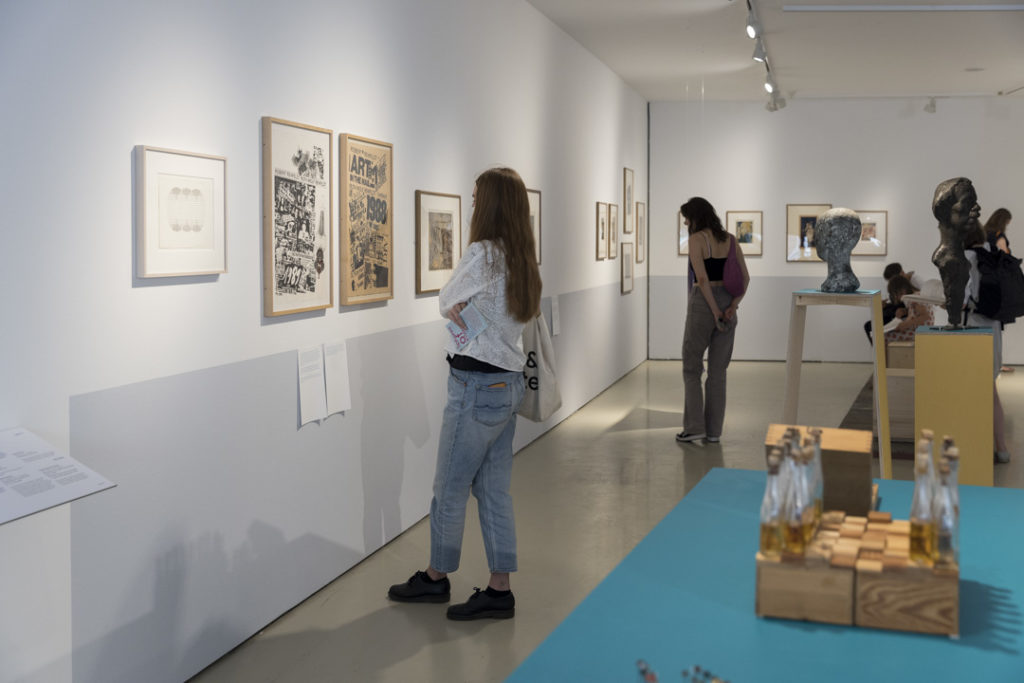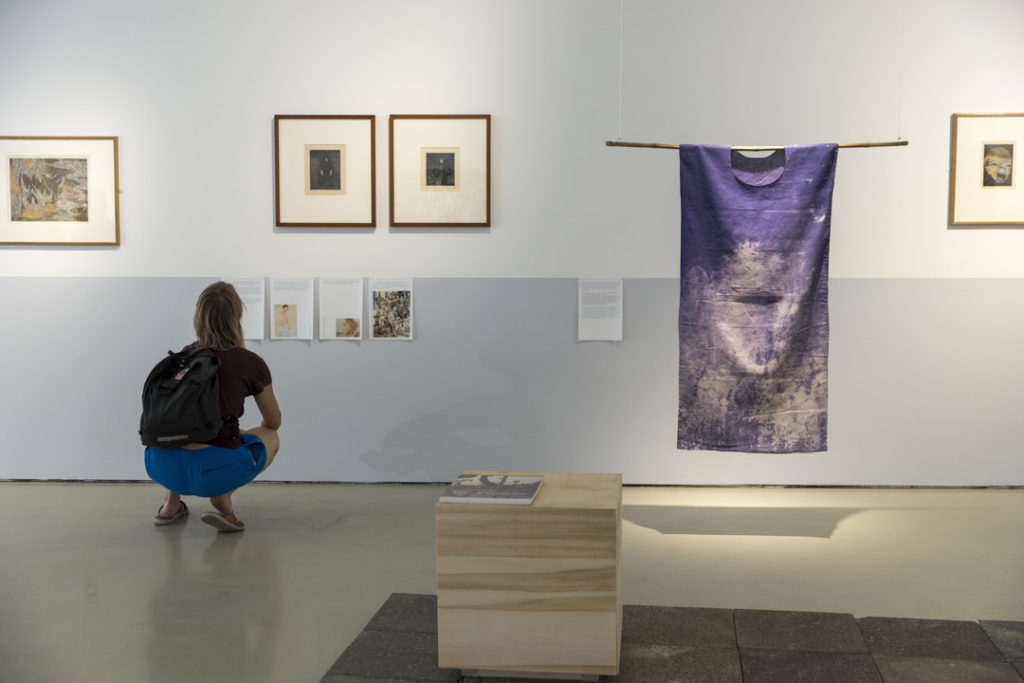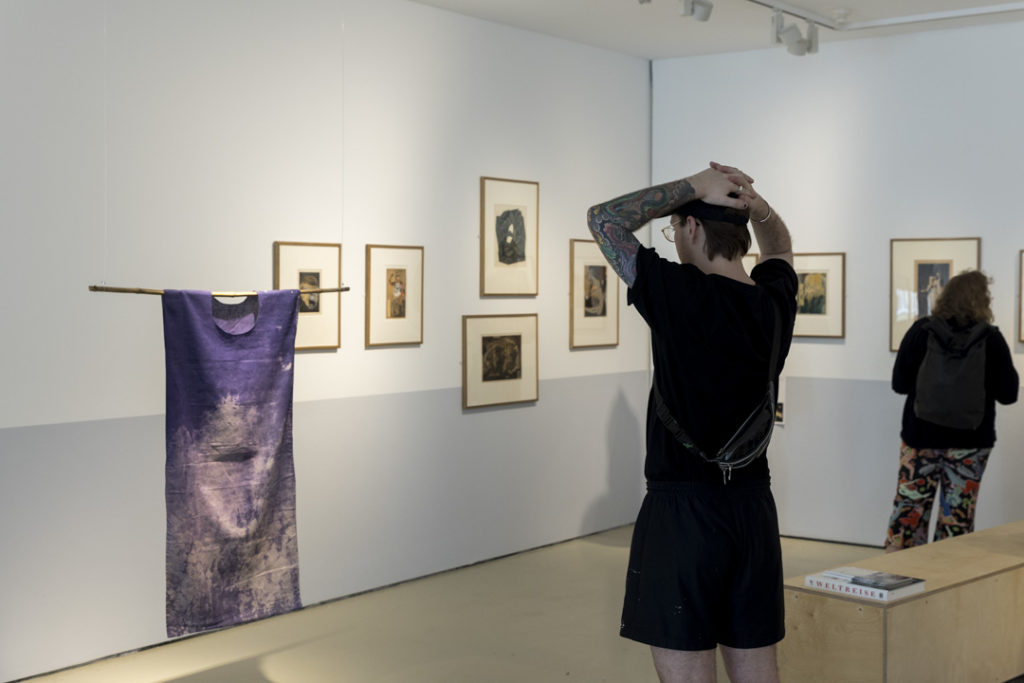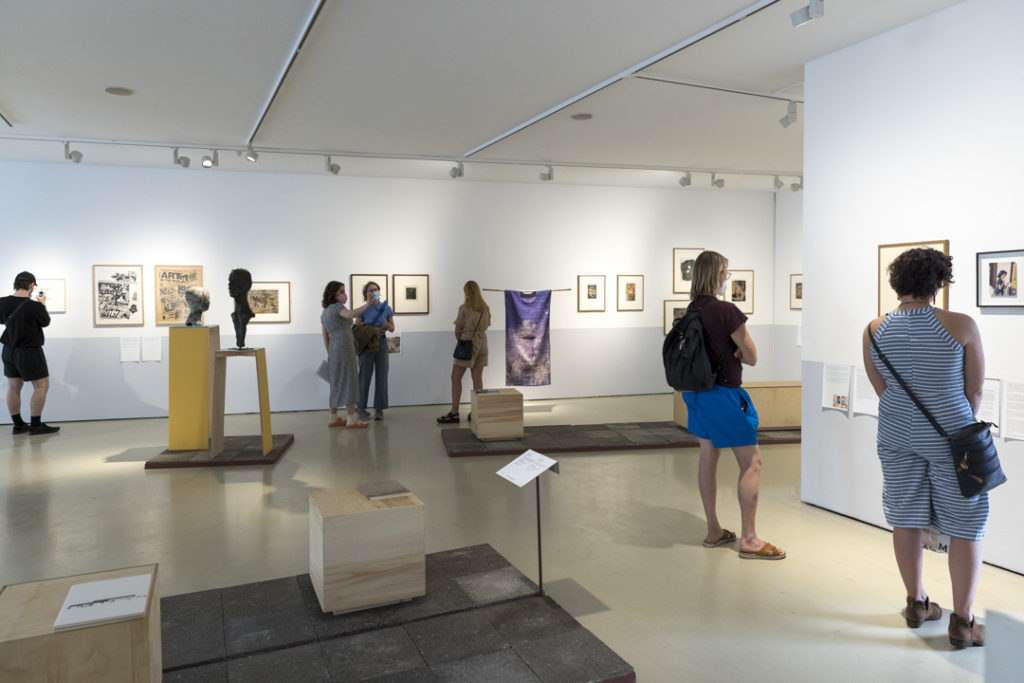Spheres of Interest (After Ruth Wolf-Rehfeldt)___stories for an archive
- 2022
- Works from the ifa collection by Ruth Wolf-Rehfeldt, Robert Rehfeld, Hanne Höch, Paoula Modersonh-Becker and Zille Hamma Hamid
- Text by Gitte Villesen
- Text and photo by Lizza May David

Looking at original works in ifa’s art deposit, Susanne mentioned that Robert Rehfeldt’s works are part of the art collection, but not the works of his wife Ruth Wolf-Rehfeldt. Checking ifa’s digital database, MuseumPlus, I noticed that one of his works is titled Hommage à Ruth [Homage to Ruth]. Later in one of the other storerooms, Maximilian pointed out that posters registered under only Robert Rehfeldt’s name contain both Ruth and Robert’s names.
Searching the web for images of works by Ruth Wolf-Rehfeldt, the first work I chose to click on was called Spheres of Interest. Another search revealed that Ruth Wolf-Rehfeldt was awarded the Hannah-Höch-Preis in 2022.
Spheres of Interest has been purchased by ifa for this show. Perhaps in this particular case the poster should be registered under both their names in MuseumPlus.

The ifa art collection includes a number of Hannah Höch’s collages. The work Komposition in Grau [Composition in grey] surprised me when I took it out of a transport crate at the depot. On the computer screen while searching the ifa’s digital database, MuseumPlus, I had found it one of the less interesting works, but now I really liked it.

Already during our first meeting, Isaac mentioned that he would like to work with the woodcut Die Mütter [The Mothers] by Käthe Kollwitz. He once made an artwork referring to another one of her works.
During a later meeting, we were looking at different works in MuseumPlus, ifa’s digital database, and Isaac compared the hands in Käthe Kollwitz’s works with the hands in Paula Modersohn-Becker’s work Sitzende Alte (“Swart war de Nacht” or “Frau mit Glotzaugen”). I would translate this very long three-part title as follows: Sitting old woman (“Black was the night” or “Woman with googly eyes”).
Another work in the collection by Paula Modersohn-Becker goes by Blinde Frau im Walde (“Klavier spielende Frau”), or Blind Woman in the Woods (“Woman Playing the Piano”). Here too the hands are quite present. Again a title which engages several stories and versions at once.
______
Paula Modersohn-Becker is often cited as one of the earliest (known) female artists to paint nude self-portraits. One of these is portrays her pregnant: Selbstbildnis am 6. Hochzeitstag [Self-portrait on the 6th wedding anniversary]. It has been speculated that she most likely wasn’t pregnant at the time she made the painting, as it was not until about a year and a half later that she gave birth to her first and only child.
______
In 1976 Ruth Wolf-Rehfeldt did a painting titled Zum Gedenken an Paula Modersohn-Becker [In memory of Paula Modersohn-Becker].
______
Right in the middle of Hannah Höch’s collage Schnitt mit dem Küchen messer Dada durch die letzte Weimarer Bierbauchkulturepoche Deutschlands [Cut with the Kitchen Knife Dada Through the Last Weimar Beer-Belly Cultural Epoch of Germany] (1919–1920), there is a small head – which belongs to Käthe Kollwitz.

During our first meeting at ifa, we were presented with a pile of catalogues covering many of ifa’s exhibitions throughout the years. We were invited to borrow some for our research. The first catalogue I was drawn to was part of the project Prêt-à-partager: a transcultural exchange in art, fashion and sports, which took the form of workshops, traveling exhibitions and conferences.
In the publication, writer, art historian and curator Antje Géra describes one of the artists, Zille Homma Hamid’s, works:
“…Hamid makes visible the manner in which textile materials are not only a storehouse of traces, but are also a medium that highlight traces. In boubou, this visualisation is performed though an act of obliteration. Part of an indigo blue cloth purchased in Dakar is worked by rubbing in a bleaching agent such that the structure of the concrete floor used as a work surface leaves its traces in the fabric itself.”
A “boubou” is a flowing robe, in this case without the typical wide sleeves. Zille Homma Hamid’s “act of obliteration” — the process described in the text — caused the fabric to become fragile. Of the six works by Zille Homma Hamid in the ifa art collection, this one is the only one which is not included in the current traveling exhibition The Event of a Thread. It is therefore the only work by her that we could see in the depot, but standing there facing the package of boubou, we decided not to unpack it, so as to spare it, knowing about its fragility.

Adrien talked about a dream he had where Ofri tells the rest of us about the project she wants to do. Ofri’s description in Adrien’s dream is quite specific and detailed.
Later on Wilhelm talked about a project by artist Carlfriedrich Claus (1939-1998) where language was freed from the heavy responsibility of meaning, or maybe he said the imprisonment of meaning.
While this went on I was thinking of a dream of my own, a dream I have tried to work with several times. Years ago while walking along the river Main in Frankfurt in drizzling rain, I was recalling a dream from the previous night. This was a period of my life where I tried to overcome a bad experience, a period where my thoughts were going in endless unproductive circles. In the dream I suddenly had the thought “just leave out the vowels.” I tried to practice this for a long time afterwards when my thoughts went in circles. It wasn’t easy, but when it worked I was freed. What was left was just noise and sounds.
If I leave out the vowels in the first paragraph of this text, it will look like this:
dr n t lks b t dr m h h d wh r fr t lls th r st f s b t th pr j ct sh w nts t d . fr ’s d scr pt n n dr n’s dr m s q t sp c f c nd d t l d.
An amazing collage by Hannah Höch is titled Traumnacht [Dream night].

In the warehouse, Susanne, Lizza and I looked at Hannah Höch’s collage Mischling [Half caste] (1924). We were all struck at first by the sensitive way it’s cut and colored. Afterwards we tried to come to terms with our discomfort with the subject and the title.
While we were looking and talking, the work was placed horizontally on a transport crate, but we were now placing it vertically against another crate at eye level, which meant that the woman in the picture was suddenly looking back at us. The effect was surprisingly strong.
Lizza mentioned that it reminded her of a photograph which is part of her own project. A photo taken by her stepfather, who in his youth had been invited as a German photographer to the Philippines. In the photo, a young girl turns and looks directly into the camera. The photograph carries the title Unknown Filipina (titled by Lizza).______Mischling [Half caste] is part of a series called Aus einem ethnographischen Museum [From an Ethnographic Museum] (ca. 1925-30). In the essay Collaging a Racial Other: Hannah Höch’s Indian Dancer (1930) Eliza Browning writes:
“Both Einstein’s argument for the sophistication of African sculpture and Höch’s association of the modern German woman with Africa would become increasingly subversive positions to take in the later years of the Weimar Republic, when any identification with non-Western art was perceived as a direct challenge to the white supremacy of Nazi ideology. Under Hitler’s ascent to power, nonwhite Germans were threatened by the deadly agenda of a united white-only Germany. In 1923, Germany defaulted on its postwar reparation payments and the Rhineland was occupied by Black French troops, prompting a flood of racist articles and newsreels about the “Black Horror on the Rhine,” where hordes of “savages” allegedly pillaged the countryside and raped German women, resulting in Misch lings kinder (children of mixed race). Hoch’s photomontage Mischling (1924) directly engages with the white supremacist fear of racial mixing, suggesting it silences and oppresses the voices of people of color. We may now see her critique of racism as foreshadowing the horrors of the Holocaust. In the 1920s, it pitted Höch and her follow Dadaists in direct political opposition with the Nazis.
… Her complex and nuanced response encapsulates changing attitudes toward gender and race in the Weimar Republic; it both repeates dated racial ideologies while holding out potential tools to deconstruct and decolonize them.”
- 2022
- Works from the ifa collection by Ruth Wolf-Rehfeldt, Robert Rehfeld, Hanne Höch, Paoula Modersonh-Becker and Zille Hamma Hamid
- Text by Gitte Villesen
- Text and photo by Lizza May David
Six artist were invited over two shows to reflect and do works related to the ifa art collection. The shows were curated by Inka Gressel and Susanne Weiß.
Here – Gitte Villesen’s contribution and part of Lizza May David’s contribution to the first exhibition are documented.
The other four artists in the exhibitions were Isaac Chong Wai, Wilhelm Klotzek, Ofri Lapid and Adrien Missika.
„Spheres of Interest (After Ruth Wolf-Rehfeldt)“ from June 24–September 18, 2022.
„Chains of Interest“ from September 30, 2022–January 22, 2023.
Photoes by Anika Buessemeier.